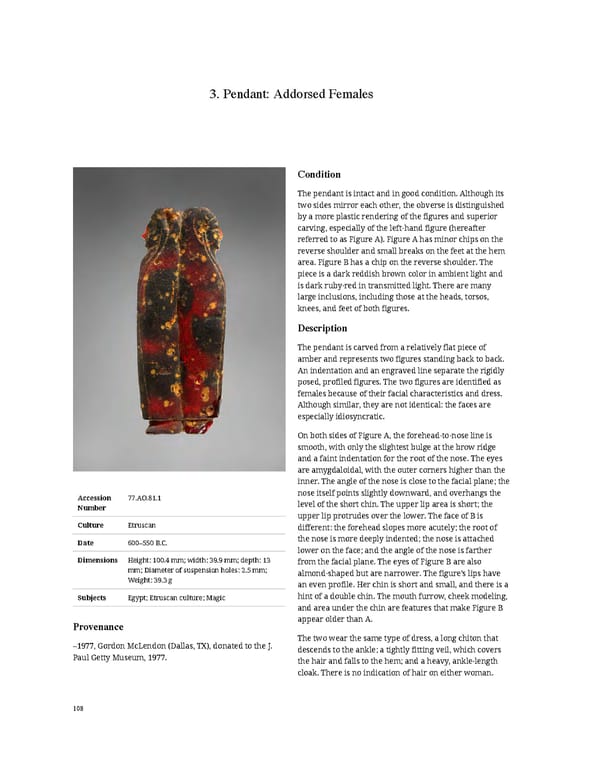3. Pendant: Addorsed Females Condition The pendant is intact and in good condition. Although its two sides mirror each other, the obverse is distinguished by a more plastic rendering of the figures and superior carving, especially of the left-hand figure (hereafter referred to as Figure A). Figure A has minor chips on the reverse shoulder and small breaks on the feet at the hem area. Figure B has a chip on the reverse shoulder. The piece is a dark reddish brown color in ambient light and is dark ruby-red in transmitted light. There are many large inclusions, including those at the heads, torsos, knees, and feet of both figures. Description The pendant is carved from a relatively flat piece of amber and represents two figures standing back to back. An indentation and an engraved line separate the rigidly posed, profiled figures. The two figures are identified as females because of their facial characteristics and dress. Although similar, they are not identical: the faces are especially idiosyncratic. On both sides of Figure A, the forehead-to-nose line is smooth, with only the slightest bulge at the brow ridge and a faint indentation for the root of the nose. The eyes are amygdaloidal, with the outer corners higher than the inner. The angle of the nose is close to the facial plane; the Accession 77.AO.81.1 nose itself points slightly downward, and overhangs the Number level of the short chin. The upper lip area is short; the upper lip protrudes over the lower. The face of B is Culture Etruscan different: the forehead slopes more acutely; the root of Date 600–550 B.C. the nose is more deeply indented; the nose is attached lower on the face; and the angle of the nose is farther Dimensions Height: 100.4 mm; width: 39.9 mm; depth: 13 from the facial plane. The eyes of Figure B are also mm; Diameter of suspension holes: 2.5 mm; almond-shaped but are narrower. The figure’s lips have Weight: 39.3 g an even profile. Her chin is short and small, and there is a Subjects Egypt; Etruscan culture; Magic hint of a double chin. The mouth furrow, cheek modeling, and area under the chin are features that make Figure B Provenance appear older than A. The two wear the same type of dress, a long chiton that –1977, Gordon McLendon (Dallas, TX), donated to the J. descends to the ankle; a tightly fitting veil, which covers Paul Getty Museum, 1977. the hair and falls to the hem; and a heavy, ankle-length cloak. There is no indication of hair on either woman. 108
 Ancient Carved Ambers in the J. Paul Getty Museum Page 117 Page 119
Ancient Carved Ambers in the J. Paul Getty Museum Page 117 Page 119